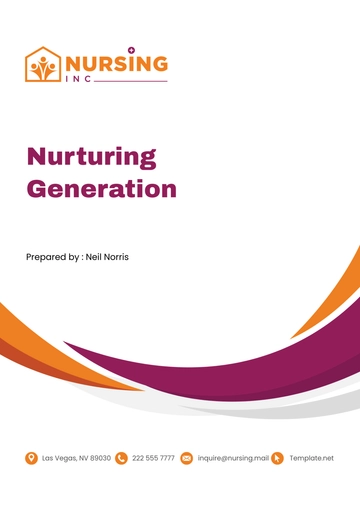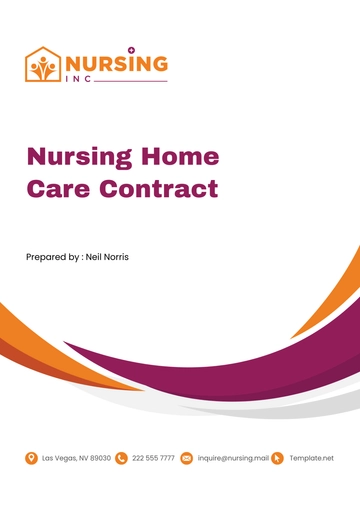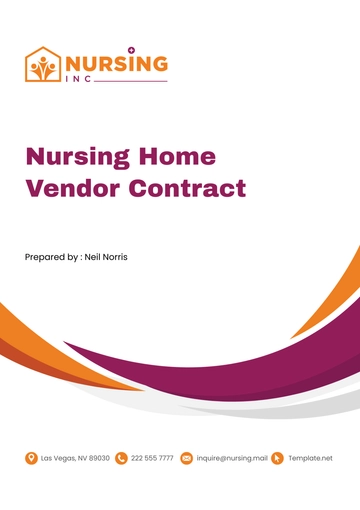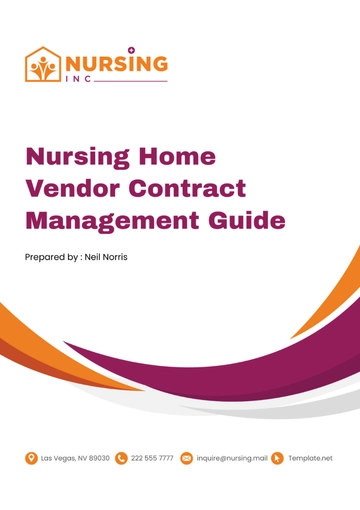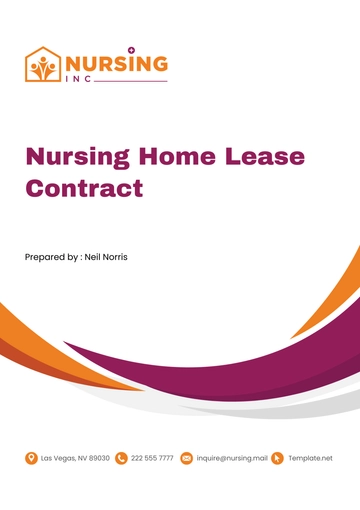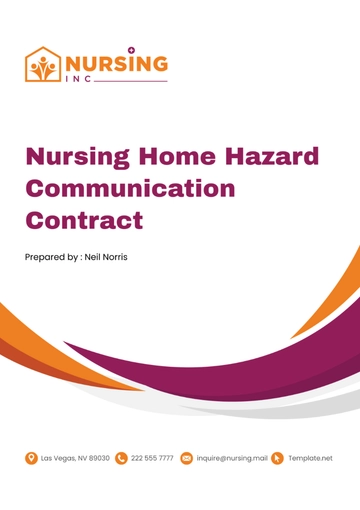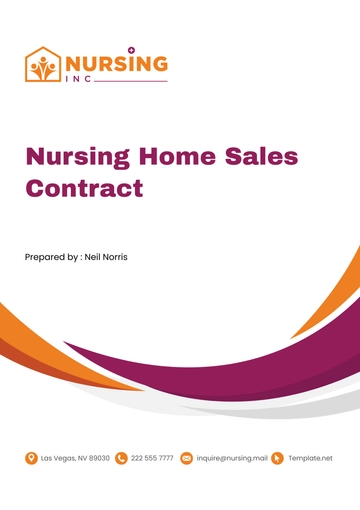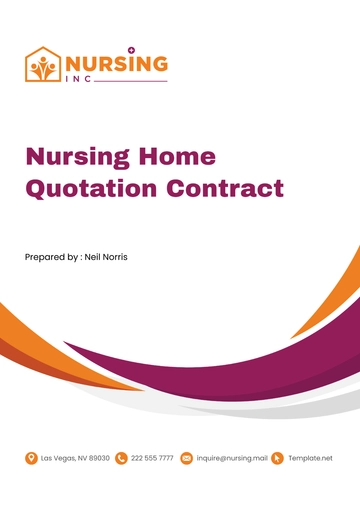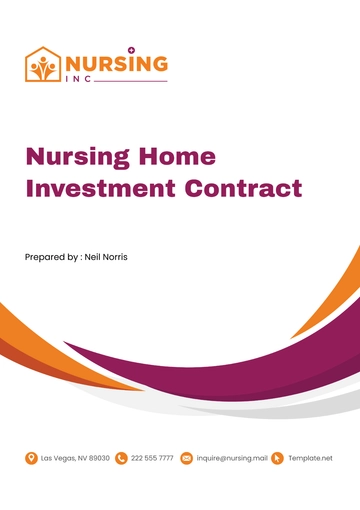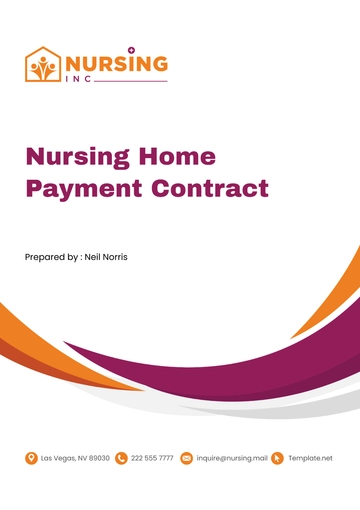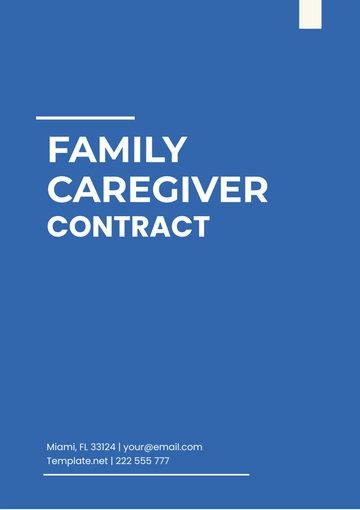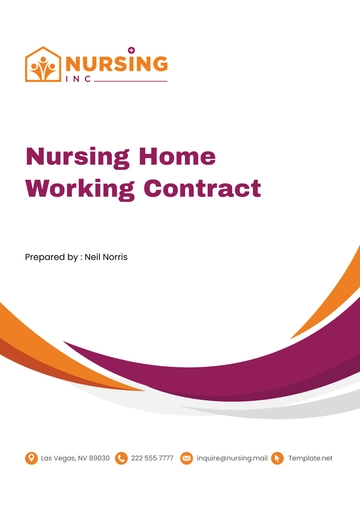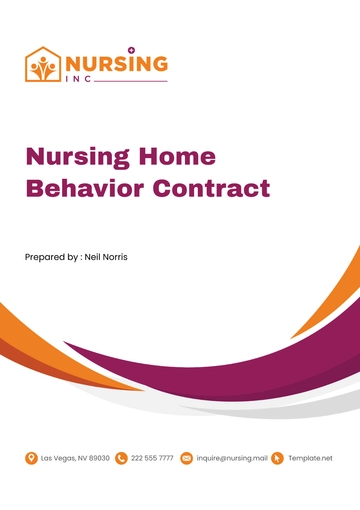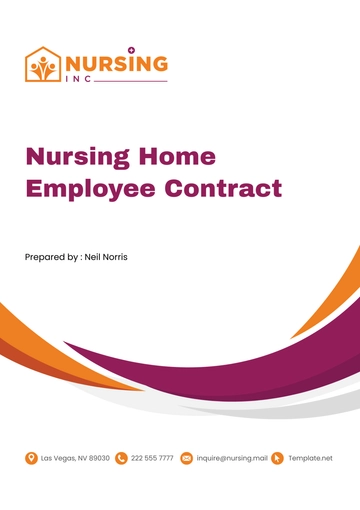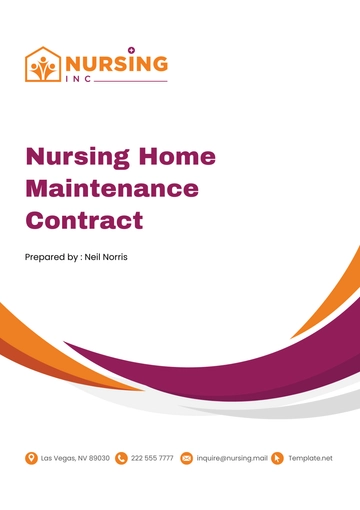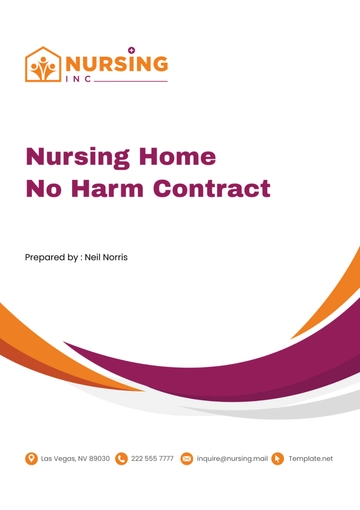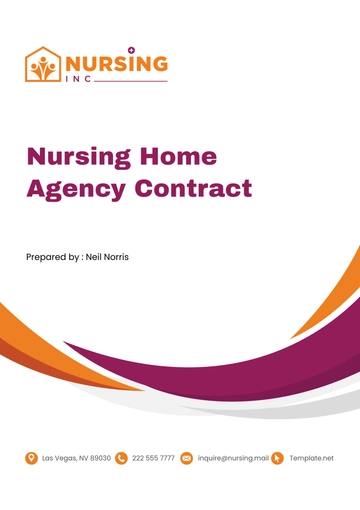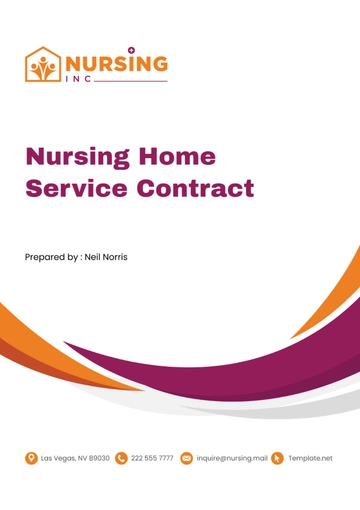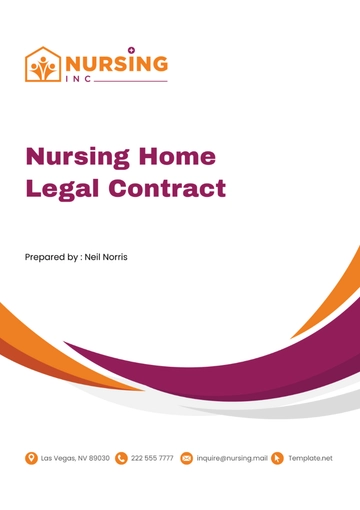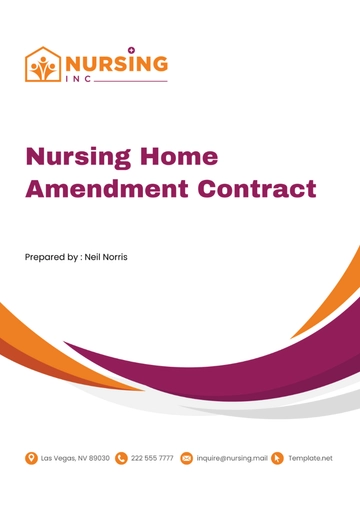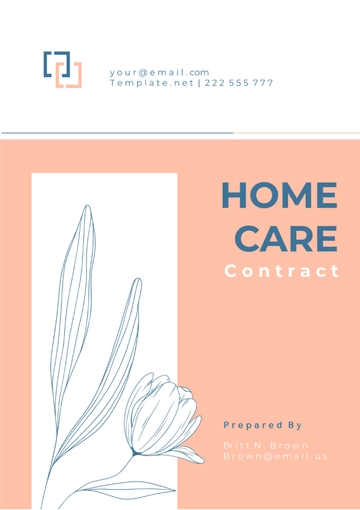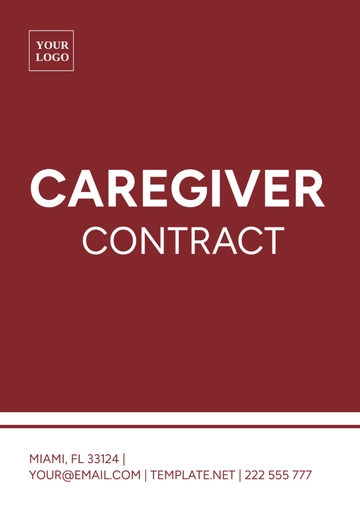Free Nursing Home Hazard Communication Contract
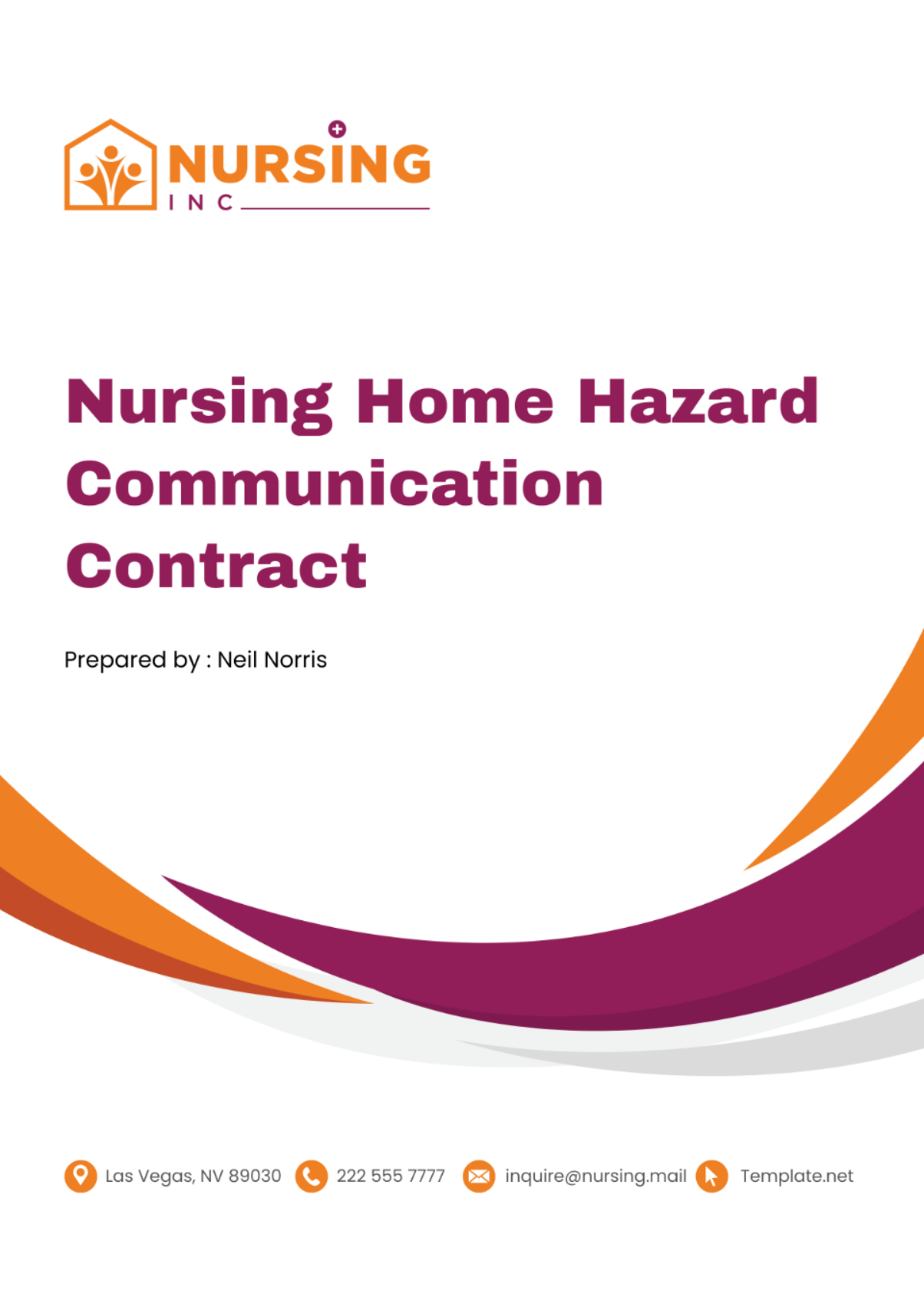
I. The Parties
This Nursing Home Hazard Communication Contract ("Agreement") is made effective as of [Month Day, Year] ("Effective Date") by and between:
A. Provider
Name: The Provider is [Your Company Name].
Address: The Provider’s address is [Your Company Address].
Role: The Provider operates a nursing home facility and is responsible for ensuring the safety and well-being of the Resident.
and
B. Resident
Name: The Resident is [Resident’s Name].
Address: The Resident’s address is [Resident’s Address].
Role: The Resident is an individual residing in the Provider’s nursing home facility.
collectively referred to as the ("Parties").
WHEREAS, the Provider is engaged in the operation of a nursing home facility and has implemented a comprehensive hazard communication program to ensure the safety and well-being of its residents;
WHEREAS, the Resident acknowledges the importance of understanding and adhering to the Provider’s hazard communication policies and procedures to maintain a safe living environment;
WHEREAS, the Parties wish to set forth in writing the terms and conditions of their agreement concerning the Provider’s hazard communication policies and procedures;
NOW, THEREFORE, in consideration of the mutual covenants contained herein and for other good and valuable consideration, the receipt and sufficiency of which is hereby acknowledged, the Parties agree as follows:
II. Purpose of the Contract
The purpose of this Contract is to establish the responsibilities and obligations of both parties in relation to hazard communication within the nursing home facility:
A. Ensuring Safety
Primary Objective: The primary objective of this Contract is to ensure the safety and well-being of the Resident within the nursing home facility operated by the Provider.
Hazard Identification: The Contract outlines the Provider’s responsibility to identify potential hazards within the nursing home facility.
Risk Mitigation: The Contract emphasizes the importance of implementing measures to mitigate identified risks and hazards.
B. Promoting Communication
Open Communication: The Contract promotes open and transparent communication between the Provider and the Resident regarding potential hazards.
Timely Updates: The Contract stipulates that the Provider must provide timely updates to the Resident about any identified hazards and the measures taken to mitigate them.
Feedback Mechanism: The Contract encourages the Resident to provide feedback and report any potential hazards that the Provider may not have identified.
C. Establishing Responsibilities
Provider’s Responsibilities: The Contract clearly outlines the responsibilities of the Provider, including hazard identification, risk mitigation, and communication.
Resident’s Responsibilities: The Contract also outlines the responsibilities of the Resident, including understanding the communicated hazards, adhering to safety measures, and reporting unidentified hazards.
Shared Responsibility: The Contract emphasizes that ensuring safety within the nursing home facility is a shared responsibility between the Provider and the Resident.
D. Legal Compliance
Regulatory Compliance: The Contract ensures that both the Provider and the Resident comply with all relevant local, state, and federal regulations regarding hazard communication in nursing home facilities.
Legal Protection: The Contract provides legal protection to both parties in the event of any disputes or legal issues arising from hazard communication.
Contractual Obligations: The Contract establishes the contractual obligations of both parties, ensuring that they are legally bound to fulfill their respective responsibilities.
III. Definition of Hazard Communication
A. Understanding Hazard Communication
Definition: Hazard communication is defined as the method of disseminating information about health and safety hazards present in the nursing home facility to the Resident.
Importance: The importance of hazard communication lies in its role in ensuring the safety and well-being of the Resident. It allows the Resident to be aware of potential risks and take necessary precautions.
Scope: Hazard communication covers all potential health and safety hazards, including physical, chemical, biological, and environmental hazards.
B. Components of Hazard Communication
Identification: The first step in hazard communication is the identification of potential hazards. This involves a thorough assessment of the nursing home facility to identify any potential risks.
Evaluation: Once potential hazards are identified, they are evaluated based on their severity and the likelihood of causing harm.
Communication: The identified hazards are then communicated to the Resident in a clear and understandable manner. This can be done through various means, such as safety briefings, signage, written materials, and electronic communications.
C. Compliance with Hazard Communication Standards
Regulatory Standards: The Provider’s hazard communication complies with all relevant local, state, and federal regulations, including the Occupational Safety and Health Administration’s (OSHA) Hazard Communication Standard.
Training: The Provider provides regular training to the Resident on hazard communication. This includes training on how to understand and respond to hazard communication.
Documentation: All hazard communication activities are documented for record-keeping and compliance purposes.
D. Continuous Improvement in Hazard Communication
Regular Review: The Provider conducts regular reviews of its hazard communication processes to identify areas for improvement.
Feedback: The Provider encourages feedback from the Resident on its hazard communication. This feedback is used to make necessary improvements.
Updates: The Provider makes regular updates to its communication based on the results of its reviews and feedback from the Resident.
IV. Responsibilities of the Provider
A. Hazard Identification
Risk Assessment: The Provider is responsible for conducting regular risk assessments to identify potential hazards in the nursing home facility. These assessments should cover all areas of the facility and all types of potential hazards, including:
1.1. Physical Hazards: These include any conditions or factors that can cause bodily harm. Examples include wet floors, poor lighting, and obstacles in walkways.
1.2. Chemical Hazards: These involve exposure to chemicals in the workplace. In a nursing home, this could include cleaning supplies, medications, or certain medical equipment.
1.3. Biological Hazards: These are related to exposure to infectious materials. In a nursing home, this could include exposure to bloodborne pathogens or infectious diseases.
1.4. Environmental Hazards: These are related to the environment in which the nursing home operates. This could include poor air quality, extreme temperatures, or noise pollution.
Inspections: The Provider is also responsible for carrying out regular inspections of the nursing home facility to identify any new or previously unrecognized hazards. These inspections should be thorough and systematic, covering all areas of the facility.
2.1. Regular Inspections: Regular inspections are conducted on a routine basis, such as weekly or monthly, to ensure that the nursing home environment remains safe.
2.2. Incident-Based Inspections: These inspections are conducted in response to a specific incident or accident to identify any hazards that may have contributed to the event.
2.3. Change-Based Inspections: These inspections are conducted when there are significant changes in the nursing home, such as new equipment or procedures, to identify any new hazards that may have been introduced.
Reporting: The Provider should maintain a system for reporting identified hazards, and should promptly communicate these hazards to the Resident.
3.1. Hazard Reporting System: The Provider should have a system in place for staff to report any hazards they identify. This system should be easy to use and accessible to all staff.
3.2. Communication of Hazards: Once a hazard is identified and reported, the Provider should promptly communicate this information to the Resident. This communication should be clear and understandable, and should include information about the nature of the hazard and any precautions the Resident should take.
B. Hazard Communication
Timely Communication: The Provider is responsible for communicating identified hazards to the Resident. This ensures that the Resident is aware of the hazards and can take necessary precautions.
1.1. Immediate Communication: For serious hazards that pose an immediate risk, the Provider should communicate this information to the Resident immediately.
1.2. Routine Communication: For less serious hazards, the Provider should communicate this information to the Resident as part of their regular hazard communication updates.
Clear Communication: The Provider should ensure that the communication about hazards is clear, understandable, and accessible to the Resident. This may involve using:
2.1. Simple Language: The Provider should avoid using technical jargon or complex language when communicating about hazards. Instead, they should use simple, plain language that the Resident can easily understand.
2.2. Visual Aids: The Provider may use visual aids, such as diagrams or pictures, to help explain the hazards. This can be particularly helpful for Residents who may have difficulty understanding written or verbal information.
Safety Briefings: The Provider should conduct regular safety briefings to inform the Resident about the hazards in the nursing home facility and the measures taken to mitigate them.
3.1. Regular Briefings: The Provider should hold regular safety briefings, such as weekly or monthly, to keep the Resident informed about any hazards in the nursing home facility.
3.2. Incident-Based Briefings: In addition to regular briefings, the Provider should also hold safety briefings in response to specific incidents or accidents. These briefings should provide information about the incident, any hazards involved, and the steps taken to prevent similar incidents in the future.
C. Hazard Prevention and Control
Prevention Measures: The Provider is responsible for implementing measures to prevent the occurrence of hazards in the nursing home facility. This may involve:
1.1. Work Practice Controls: These are changes in the way work is performed to reduce the risk of exposure to hazards. This could include providing training on safe work practices, implementing safety procedures, or modifying the way tasks are performed.
1.2. Engineering Controls: These are physical changes to the workplace that reduce or eliminate the risk of hazards. This could include installing safety equipment, improving ventilation, or redesigning workspaces to eliminate hazards.
Control Measures: If hazards cannot be completely prevented, the Provider should implement control measures to minimize the risk associated with these hazards. This may involve using:
2.1. Personal Protective Equipment (PPE): If a hazard cannot be eliminated or controlled at the source, the Provider may provide PPE to protect the Resident from the hazard. This could include gloves, masks, or safety glasses.
2.2. Administrative Controls: These are changes in work procedures such as written safety policies and rules, schedule changes, or worker training.
Emergency Procedures: The Provider should establish emergency procedures to respond to incidents involving hazards. These procedures should be communicated to the Resident and regularly reviewed and updated.
3.1. Emergency Plan: The Provider should have a written emergency plan that outlines the steps to be taken in the event of an emergency. This plan should be communicated to the Resident and all staff members.
3.2. Emergency Drills: The Provider should conduct regular emergency drills to ensure that all residents and staff are familiar with the emergency procedures.
3.3. Emergency Equipment: The Provider should ensure that appropriate emergency equipment, such as fire extinguishers and first aid kits, are available and easily accessible in case of an emergency.
V. Responsibilities of the Resident
A. Understanding of Hazards
Active Participation: The Resident is expected to actively participate in safety briefings and other hazard communication activities conducted by the Provider. This includes:
1.1. Engagement in Briefings: The Resident should actively engage in safety briefings, asking questions and discussing any concerns they may have.
1.2. Understanding Information: The Resident should take the time to understand the information provided about hazards. If any information is unclear, they should ask the Provider for clarification.
1.3. Seeking Additional Information: If the Resident feels they need more information about a particular hazard, they should feel comfortable asking the Provider for additional information.
Awareness of Risks: The Resident should be aware of the risks associated with the identified hazards and the importance of adhering to safety measures.
2.1. Risk Awareness: The Resident should understand the potential risks associated with each identified hazard. This includes understanding the potential consequences of exposure to the hazard and the likelihood of such exposure.
2.2. Importance of Safety Measures: The Resident should understand the importance of adhering to safety measures. This includes understanding how each safety measure helps to mitigate the associated risk.
Self-Education: The Resident should take the initiative to educate themselves about potential hazards and safety measures.
3.1. Research: The Resident can conduct their own research to learn more about the identified hazards and how to protect themselves.
3.2. Training: The Resident can seek additional training or education on hazard identification and safety measures.
B. Compliance with Safety Measures
Adherence to Safety Measures: The Resident is responsible for adhering to all safety measures implemented by the Provider in relation to identified hazards.
1.1. Following Procedures: The Resident should follow all safety procedures and instructions provided by the Provider. This includes understanding and complying with evacuation plans, emergency procedures, and any specific instructions related to the use of equipment or facilities.
1.2. Using Safety Equipment: If the Provider provides safety equipment, such as personal protective equipment (PPE), the Resident should use this equipment as instructed. This could include wearing gloves or masks when necessary, or using safety rails or other assistive devices.
1.3. Avoiding Hazards: The Resident should avoid areas or activities that have been identified as hazardous unless necessary and they have received appropriate safety training. This includes staying away from restricted areas and not engaging in activities that could pose a risk to their health or safety.
Reporting Non-Compliance: The Resident should report any non-compliance with safety measures to the Provider.
2.1. Observing Non-Compliance: If the Resident observes any non-compliance with safety measures, such as other residents not wearing required personal protective equipment, they should report this to the Provider. This helps ensure the safety of all residents in the facility.
2.2. Reporting Unsafe Conditions: If the Resident observes any unsafe conditions, such as a spill that could cause a slip and fall, they should immediately report this to the Provider. This allows the Provider to take immediate action to mitigate the hazard.
Cooperation during Inspections and Drills: The Resident is expected to cooperate during safety inspections and participate in safety drills conducted by the Provider.
3.1. Participation in Drills: The Resident should actively participate in all safety drills, such as fire drills. This helps ensure that they know what to do in case of an actual emergency.
3.2. Cooperation during Inspections: The Resident should cooperate during safety inspections, providing access to their living area and answering any questions the inspectors may have.
C. Reporting of Hazards
Responsibility to Report: The Resident has a responsibility to report any new or unidentified hazards that they encounter in the nursing home facility.
1.1. Observation and Identification: The Resident should be observant of their surroundings and identify any potential hazards. This could include recognizing new hazards that arise or noticing changes in existing conditions that could increase the risk of a hazard.
1.2. Prompt Reporting: If the Resident identifies a potential hazard, they should report it to the Provider as soon as possible. Prompt reporting allows the Provider to take immediate action to address the hazard and prevent any harm.
1.3. Detailed Information: When reporting a hazard, the Resident should provide as much detail as possible. This includes the location of the hazard, the nature of the hazard, and any other relevant information.
Feedback on Hazard Communication: The Resident is encouraged to provide feedback on the Provider’s hazard communication.
2.1. Understanding of Communication: The Resident should provide feedback on whether they understand the hazard communication provided by the Provider. If the Resident does not understand the information, they should let the Provider know so that the Provider can improve their communication methods.
2.2. Suggestions for Improvement: The Resident is encouraged to provide suggestions for how the Provider can improve their hazard communication. This could include suggestions for different communication methods, additional information that could be provided, or ways to make the information more understandable.
Cooperation with the Provider: The Resident should cooperate with the Provider in all matters related to hazard communication. This includes participating in safety briefings, following safety procedures, and using safety equipment as instructed.
3.1. Participation in Safety Briefings: The Resident should actively participate in safety briefings conducted by the Provider. This includes listening attentively, asking questions if anything is unclear, and following any instructions given during the briefing.
3.2. Following Safety Procedures: The Resident should follow all safety procedures outlined by the Provider. This includes using safety equipment as instructed, following evacuation procedures in case of an emergency, and adhering to any restrictions or guidelines set by the Provider.
3.3. Use of Safety Equipment: If the Provider provides safety equipment, the Resident should use it as instructed. This includes wearing personal protective equipment when necessary and using safety devices such as handrails or non-slip mats.
VI. Term and Termination
A. Contract Duration
Start Date: The contract will commence on the date it is signed by both parties. This is the official start date of the contract.
End Date: The contract will remain in effect until [Month Day, Year], unless terminated earlier by either party. This is the official end date of the contract.
Contract Period: The period between the start date and the end date will be considered as the contract period. This is the duration for which the contract is valid.
B. Termination by Notice
Right to Terminate: Either party may terminate this Contract at any time by providing the other party with a written notice. This gives both parties the flexibility to end the contract if they deem it necessary.
Notice Period: The notice period for termination will be thirty [30] days unless otherwise agreed upon by both parties. This gives the other party enough time to make necessary arrangements.
Effect of Notice: Upon receipt of the termination notice, the parties will cease all work under this Contract after the expiry of the notice period. This ensures a smooth transition post-termination.
C. Early Termination
Breach of Contract: If either party breaches any terms or conditions of this Contract, the other party has the right to terminate the Contract immediately upon written notice. This ensures that the parties adhere to the terms of the contract.
Insolvency: If either party becomes insolvent, bankrupt, or enters receivership, the other party has the right to terminate this Contract immediately upon written notice. This protects the parties in case of financial instability.
Non-compliance: If the Resident fails to comply with the Provider’s Hazard Communication Program, the Provider may terminate this Contract immediately upon written notice.
D. Consequences of Termination
Payment: Upon termination, the Resident will be required to pay for all services rendered up to the date of termination. This ensures that the Provider is compensated for their work.
Return of Property: Upon termination, both parties must return any property, materials, or information obtained from the other party during the contract period. This ensures that no proprietary information is retained post-termination.
VII. Governing Law
A. Applicable Law
State Law: The laws of the state of [State Name] will govern this Contract. This includes all state statutes, regulations, and case law.
Exclusion of Conflict of Laws: The Contract will be interpreted without regard to the state’s conflict of law rules. This means that even if the laws of another jurisdiction would ordinarily apply, the laws of [State Name] will govern.
Federal Law: If a question arises under federal law, the federal law will apply.
B. Jurisdiction
Court Jurisdiction: Any legal proceedings related to this Contract will be conducted in the state of [State Name].
Consent to Jurisdiction: By entering into this Contract, both parties consent to the jurisdiction of the courts located within the state of [State Name].
C. Venue
Venue: The venue for any legal proceedings will be the county in which the Provider’s principal place of business is located.
Change of Venue: The Provider may change the venue if necessary, but it must be within the state of [State Name].
D. Interpretation of the Contract
Interpretation: The Contract will be interpreted according to the laws of the state of [State Name].
Language: The Contract is written in English. If there is a conflict between the English version and any translation, the English version controls.
VIII. Entire Agreement
A. Completeness of the Contract
Entire Agreement: This Contract represents the entire agreement between the parties. It supersedes all prior negotiations, discussions, or agreements, whether oral or written. This ensures that all terms and conditions are consolidated into this single document.
Exclusion of Other Terms: No other understandings, promises, or agreements, whether oral or written, are valid unless they are included in this Contract or are mutually agreed upon by both Parties in writing. This ensures that all agreements are documented and enforceable.
B. Modifications
Written Modifications: Any modifications to this Contract must be in writing and signed by both parties. This ensures that any changes to the Contract are mutually agreed upon and legally enforceable.
Oral Modifications: Oral modifications are not valid or enforceable. This ensures that all modifications are documented and reduces the risk of misunderstandings or disputes.
C. Interpretation
Fair Interpretation: This Contract will be interpreted fairly and not in favor of or against either party. This ensures that the Contract is interpreted in a balanced and unbiased manner.
Severability: If any provision of this Contract is found to be invalid or unenforceable, the remaining provisions will remain in effect. This ensures that the rest of the Contract remains valid even if one part is found to be invalid.
IX. Dispute Resolution
A. Agreement to Arbitrate
Arbitration Agreement: Both parties agree to resolve any disputes arising out of or related to this Contract through arbitration. This means that both parties give up their right to go to court to assert or defend their rights.
Scope of Arbitration Agreement: The arbitration agreement applies to any and all disputes arising out of or related to this Contract, or the termination of this Contract, including but not limited to claims for breach of contract, negligence, or any other common law or statutory claims.
Binding Arbitration: The arbitration will be binding, meaning that the decision of the arbitrator will be final and cannot be appealed or reviewed by a court.
B. Arbitration Procedures
Arbitration Rules: The arbitration will be conducted in accordance with the rules of the American Arbitration Association, which are designed to ensure that the arbitration process is fair and efficient.
Selection of Arbitrator: The parties will jointly select a neutral arbitrator. If the parties cannot agree on an arbitrator, one will be appointed in accordance with the rules of the American Arbitration Association.
Arbitration Location: The arbitration will take place in the state of [State Name], unless the parties agree to a different location.
C. Arbitration Award
Arbitration Decision: The arbitrator will render a decision based on the evidence and arguments presented by the parties. The decision of the arbitrator will be final and binding on both parties.
Award: The arbitrator may award any relief that a court could award, including monetary damages, injunctive relief, and declaratory relief.
Enforcement: The arbitration award may be enforced in any court of competent jurisdiction.
D. Costs of Arbitration
Arbitration Fees: Each party will be responsible for their own arbitration fees, unless the arbitrator decides otherwise.
Attorney’s Fees: Each party will be responsible for their own attorney’s fees, unless the arbitrator decides otherwise or the Contract provides for the recovery of attorney’s fees.
X. Signatures
IN WITNESS WHEREOF, the parties have executed this Contract as of the Effective Date.
Provider

[Authorized Representative Name]
[Your Company Name]
Date: [Month Day, Year]
Resident

[Resident's Name]
Date: [Month Day, Year]
- 100% Customizable, free editor
- Access 1 Million+ Templates, photo’s & graphics
- Download or share as a template
- Click and replace photos, graphics, text, backgrounds
- Resize, crop, AI write & more
- Access advanced editor
Enhance hazard communication with this editable and customizable Nursing Home Hazard Communication Contract Template from Template.net! This resource offers a structured hazard communication agreement. Make use of the AI Editor Tool to ensure clear and comprehensive communication of hazards and safety protocols, fostering a safe environment for residents and staff!
You may also like
- Rental Contract
- Contractor Contract
- Contract Agreement
- One Page Contract
- School Contract
- Social Media Contract
- Service Contract
- Business Contract
- Restaurant Contract
- Marketing Contract
- Real Estate Contract
- IT Contract
- Cleaning Contract
- Property Contract
- Supplier Contract
- Partnership Contract
- Food Business Contract
- Construction Contract
- Employment Contract
- Investment Contract
- Project Contract
- Payment Contract
- Student Contract
- Travel Agency Contract
- Startup Contract
- Annual Maintenance Contract
- Employee Contract
- Gym Contract
- Event Planning Contract
- Personal Contract
- Nursing Home Contract
- Law Firm Contract
- Work from Home Contract
- Software Development Contract
- Maintenance Contract
- Music Contract
- Amendment Contract
- Band Contract
- DJ Contract
- University Contract
- Salon Contract
- Renovation Contract
- Photography Contract
- Lawn Care Contract
